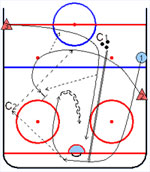|
|
Basics. Basics. Basics.
As it does with any sport, improving at hockey means starting with the basics. Better play means learning Basic skills and good habits, and then refining and building on them. Drills and plays develop complexity as the player’s skills develop, but they will always rely on basic technique. And above all, this is supposed to be fun – so why would we create a boring practice?
Habits.
There are a billion good or bad habits that players develop on the ice, but there are a few that stand out above all others. We push these habits with every drill we run because you will always play as you practice.
- Be aware– Always keep your head up and be alert.
- Skate hard – Keep moving, never be caught flat footed.
- Recover quickly– Get up as fast as you went down, regain the puck as fast as you lost it.
- Never give up on the puck – You never know what opportunity you might create.
All of the on-ice drills we run can be dropped into one of the three fundamentals: Skating, Puck work and Positional/Team play. Everything in hockey comes back to these, and the skill-sets encompassed by each.
 - Skating
The most fundamental skill there is, and yet everyone would rather work on their slap shot. In a game situation, If you can’t get into position, how are you going to get a shot away?
There are seven elements to a basic forward stride, and we work each of them with and without the puck. Add Turns, crossover/unders (both backwards and forwards) and because this is hockey, you have to be able to do it with the puck as well. Aggressive stops and explosive starts, balance, power, speed and edgework round out the short list of skating basics. And yes, we have drills for every single one.
 2. Puck Work.
Hold on to that slap shot – wait for it. Puck handling, passing, recovering and moving the puck all take precedence here. And then there are the wrist shot and the snap shot (both on and off stride) before we’ll even look at the slap shot. Most goaltenders grin when they see the slap shot coming – it’s the most predictable and easiest to get in front of. If the shooter can even hit the net. Trust me, I know.
 3. Positional/Team play 3. Positional/Team play
Set plays and tactics are a job for a team captain or a coach when he or she has a set roster and wants to create a team system. But the ability to play positional hockey in all situations, and to play with your teammates is fundamental to the game, so we teach you to know what is happening on the ice, how to read plays and adapt. If you know where you are supposed to be at any given moment and why (as well as where your opponent is supposed to be) you will be a much more versatile and creative player.
With everything we work on, we try to impart not only the how but the why, and whenever possible we try to create a game situation to demonstrate. That may take the form of a break-in/out drill, a transition or flow exercise, or even a quick game of shinny – like I said, this is supposed to be fun. |